- Free Interview Course


CPC DRIVER CASE STUDY ASSESSMENT TESTS FULL PRACTICE MOCK TESTS
(7 Practice Driver CPC Module 2 Case Study Assessments)
Trusted by 100,000s worldwide:
Why do I need to take a Case Study Assessment? The Case Study Assessment Test is a crucial component of the Driver Certificate of Professional Competence (CPC) qualification for several reasons. Firstly, it assesses drivers’ ability to apply theoretical knowledge to real-world situations, ensuring they can make informed decisions on the road. Secondly, it promotes ongoing learning and adaptation to changes within the transportation industry, enhancing drivers’ competency and professionalism. Lastly, the test standardises evaluation criteria, ensuring all CPC holders meet consistent standards of excellence, thereby enhancing public trust and safety. In essence, the Case Study Assessment Test plays a pivotal role in upholding the integrity of the profession and safeguarding road users by ensuring drivers possess the necessary skills and knowledge to operate safely and responsibly.
ABOUT THE DRIVER CPC CASE STUDY ASSESSMENT
The Driver Certificate of Professional Competence (CPC) Case Study Assessment is a comprehensive evaluation tool designed to test drivers’ ability to apply their knowledge and expertise in real-world scenarios. Through a series of carefully crafted case studies, drivers are presented with challenging situations that they may encounter during their professional driving careers. These case studies cover a wide range of topics, including road safety, vehicle maintenance, driver health and well-being, and compliance with legal and regulatory requirements. By assessing how drivers analyse, prioritise, and respond to these scenarios, the Case Study Assessment provides valuable insights into their practical skills, decision-making abilities, and overall readiness to operate safely and effectively on the road.
Moreover, the Case Study Assessment serves as a dynamic learning experience for drivers, offering opportunities to deepen their understanding of industry standards, best practices, and emerging issues. By engaging with realistic case studies, drivers are encouraged to reflect on their own practices, identify areas for improvement, and stay abreast of developments within the transportation sector. The test itself is made up of 50 questions presented in groups of 6-8 questions per scenario. The test will contain six different scenarios.
ACCESS THE ONLINE DRIVER CPC CASE STUDY MOCK TESTS NOW (CONTAINS 7 COMPREHENSIVE FULL MOCK TESTS WITH A TOTAL OF 350 QUESTIONS, ANSWERS AND EXPLANATIONS)
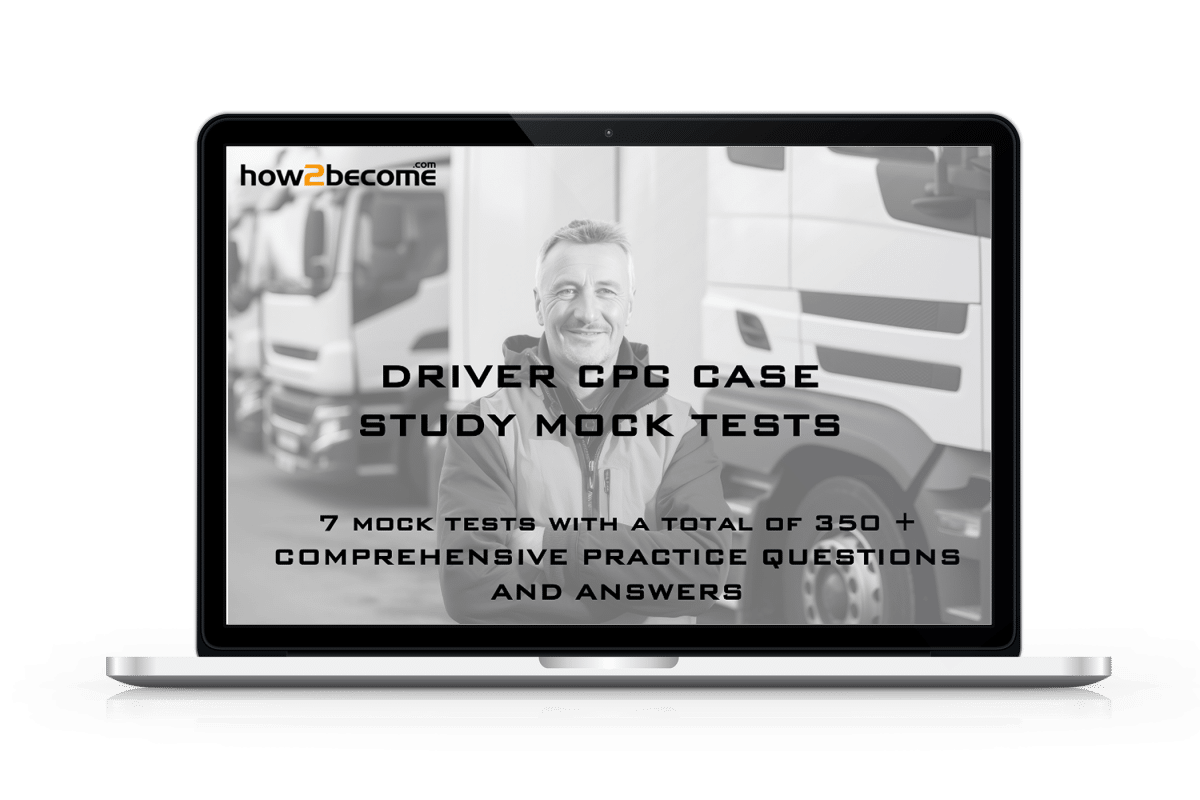
CPC DRIVER CASE STUDY ASSESSMENT PRACTICE SCENARIOS!
A CPC driver case study scenario typically contains a detailed description of a real-world situation that a professional driver may encounter during their work. These scenarios cover a wide range of topics related to driving, road safety, and the transportation industry. Here are some elements commonly found in a CPC driver case study scenario:
Background information
The scenario often begins with background information, setting the context for the situation. This may include details about the driver’s route, the type of vehicle being operated, weather conditions, traffic conditions, and any relevant logistical considerations.
Problem or challenge
The Questions may presents a specific problem or challenge that the driver must address. This could involve issues such as vehicle breakdowns, traffic accidents, adverse weather conditions, road closures, or compliance with regulations.
Decision points
The scenario typically includes decision points where the driver must make choices about how to respond to the situation. These decisions may involve prioritising safety, managing time constraints, communicating with relevant parties, or complying with legal requirements.
Consequences
The scenario outlines the potential consequences of different courses of action taken by the driver. This could include implications for safety, regulatory compliance, operational efficiency, customer satisfaction, and the driver’s professional reputation.
Reflective questions
In some cases, the scenario may include reflective questions that prompt the driver to consider their actions, evaluate alternative approaches, and reflect on lessons learned from the experience.

Now INSTANTLY access all 7 Driver CPC Case Study Mock Tests including answers and explanations.
Here's What People Are Saying...
(worldwide success stories from our YouTube community!)

1 week ago (edited)

Have an assessment centre tomorrow and praying i'll also get it.
Update: Got the job! Thank you!
2 months ago (edited)

I've got a online assessement with an investment bank coming up and would love to get the right list of questions for it 🙂
3 months ago (edited)

Thank you so much! I went today and got the job on the spot!
2 weeks ago

...they made me take a basic vocabulary and typing test...I fortunately got a call back the next day saying I got the job!
3 months ago

I have my test tomorrow...
UPDATE: I'm Hired♥️♥️ I am so happy 😊😊😊😊

Richard, After getting myself trained from your tutorials , I GOT THE BEST JOB IN AUSTRALIA 🙂 . I have to say that I cracked my assessment for a Big company because of your lessons. A big thanks to you ,God bless you.

...I'm so nervous! Hope these tips will help out :') UPDATE: I got the job!!! These tips were so helpful thank you!
6 days ago (edited)

I am sooooo NERVOUS! ...Fingers crossed 🤞🏾
UPDATE: I GOT THE JOB! 🥂🍾

Thanks to you I got the job. THANK YOU SO MUCH❤️
1 month ago

Thank u very much this helped me in my college entrance tests!

I just want to say thank you. I went to sit my test yesterday and I passed. I practiced ur test questions and it made me feel really confident!
GET INSTANT ACCESS TO 7 FULL DRIVER CPC CASE STUDY MOCK ASSESSMENTS
FOR JUST £11.99
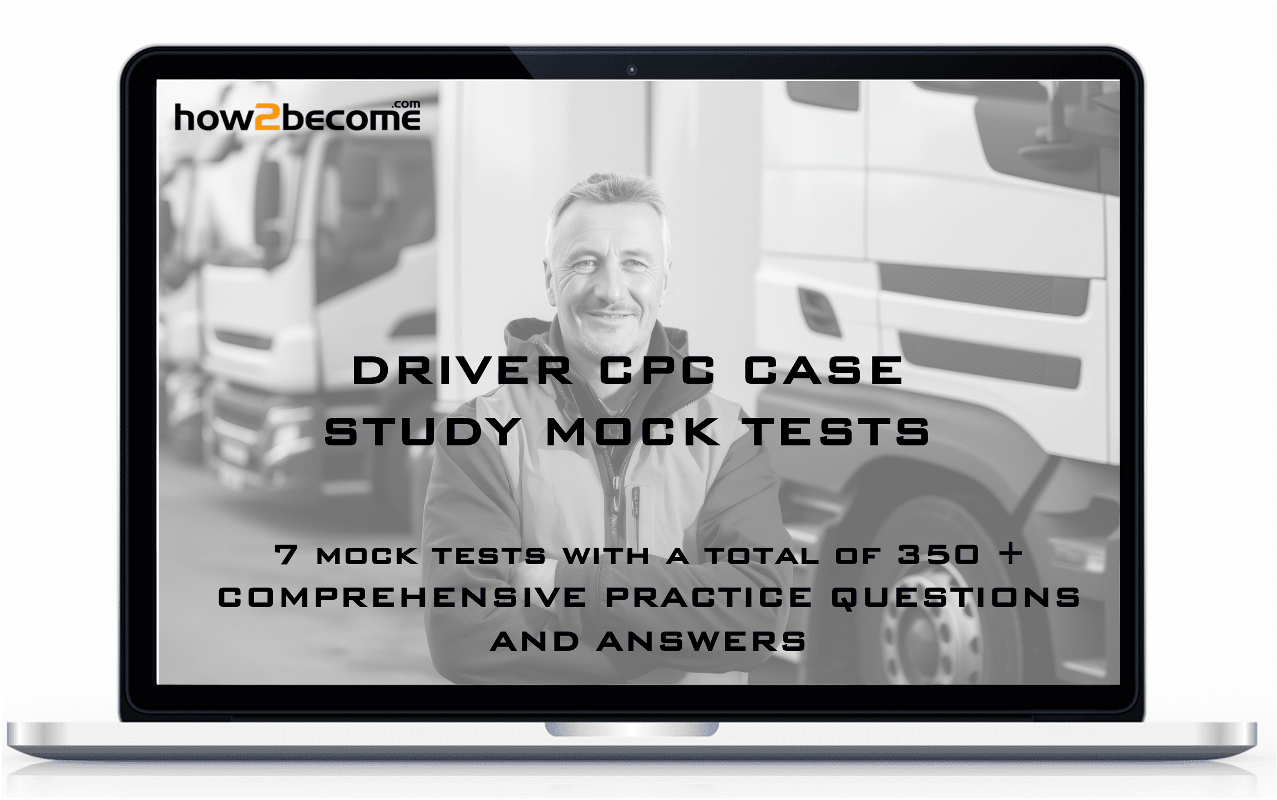
What you’ll get…
7 Full DRIVER CPC Case Study Assessment mock tests complete with 50 questions each. All questions designed to help you effectively prepare for your Driver CPC case study assessment!
Answers/explanations to all of the questions to ensure you gain an advantage and pass.
In-depth and challenging scenarios designed to ensure you get the maximum benefit from each assessment.
Instant access to the mock tests and vital study guides via our comprehensive online testing system.
All of the above for just £11.99.
Pass your Driver CPC Case Study Assessment today. Trusted by 10,000s of customers worldwide.
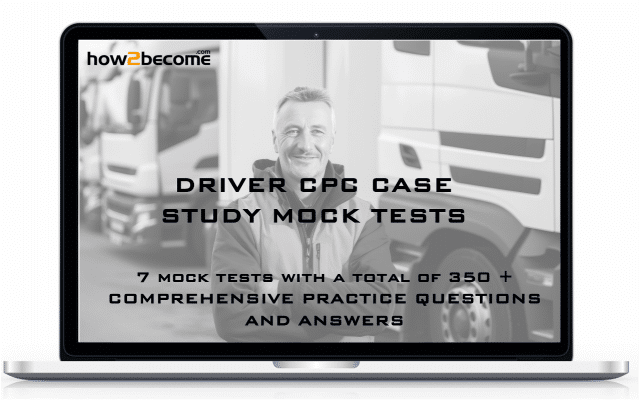
- 30-Day Money Back Guarantee
PLUS… BONUS In addition to the Case Study Assessment Pack, you will also receive the following BONUS:
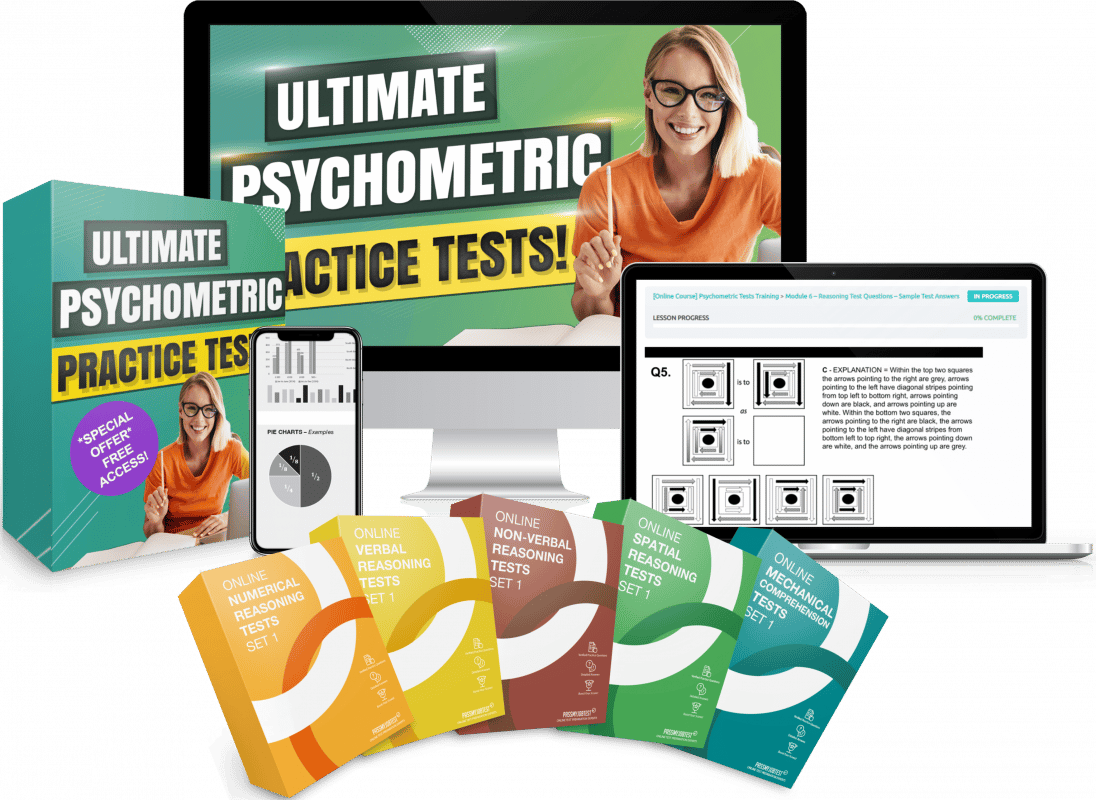
Online Psychometric Test Training Course – FREE bonus access to our bestselling online psychometric training course, which contains over 30 powerful video modules to quickly get you assessment-ready (and they work for ANY assessment). This online course will instantly be free for you to access via a 30-day trial, thereafter, it is automatically renewed at just £27+vat per month. No minimum terms. Cancel anytime. Limited time offer.

30-DAY MONEYBACK GUARANTEE
We have eliminated all risk for you. All of our products and training resources are protected by our 30-day no questions asked money-back guarantee. Whatever the reason…or no reason at all…you can have a full refund if this resource isn’t right for you. So there is no risk.
Who has created the questions and answers to the test questions?
Richard McMunn is a former Fire Officer turned psychometric assessment coach who has over 20 years experience within the recruitment industry.
He is extremely passionate about helping people pass their assessments, and his success rate is unrivalled within the assessment training sector.

Still not convinced? Here’s why you should buy with How2Become.com…
Firstly, these practice questions and answers are created by us and our team of experts – we have all the most commonly used (and less common) practice questions industry assessors are using and we will help you succeed (like we’ve been doing for the last 17 years) and we update our material frequently.
Secondly, we provide exclusive bonuses with all our products that you won’t find anywhere else. These bonuses include free guides, powerful online training and more!
Thirdly, our testing preparation packages and training just work. Take a look at our customer reviews and feedback where our customers share their positive buying experiences and more importantly the time-saving success our resources have given them (hint: they passed their job assessments).
Finally, we have eliminated all risk for you. All of our products and resources are protected by our 30-day no questions asked money-back guarantee. Whatever the reason…or no reason at all…you can have a full refund if this training isn’t right for you. So there is no risk.
MORE TESTIMONIALS
Having helped 100,000s of candidates over the past 17 years, it is no wonder our community loves us…
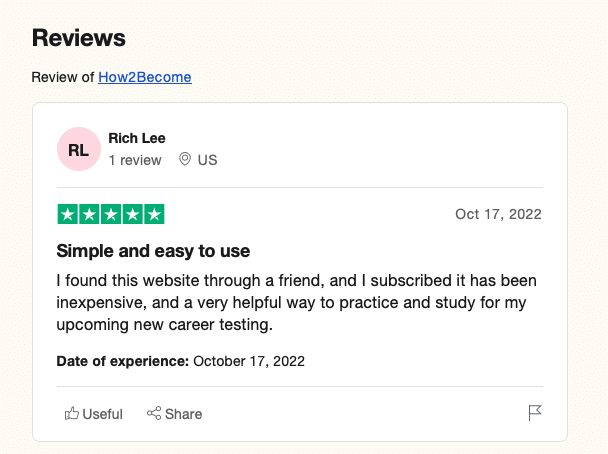
*100,000+ relates to all How2Become resources designed to help people like you pass their recruitment processes being used worldwide.
- Free Aptitude Tests

- Privacy Overview
- Strictly Necessary Cookies
This website uses cookies so that we can provide you with the best user experience possible. Cookie information is stored in your browser and performs functions such as recognising you when you return to our website and helping our team to understand which sections of the website you find most interesting and useful.
Strictly Necessary Cookie should be enabled at all times so that we can save your preferences for cookie settings.
If you disable this cookie, we will not be able to save your preferences. This means that every time you visit this website you will need to enable or disable cookies again.

Understand and book your official RSA Theory Test
CPC - Driver Certificate of Professional Competence

You are here: Home » Book your Theory Test » CPC – Driver Certificate of Professional Competence
About the Driver CPC Theory Test
In order to professionally drive a Bus and/or a Truck you will need* to have a passed a Category D Bus and/or Category C Truck Driver Theory Test and the Driver CPC Case Study Test detailed below, before you can apply to the RSA for your Driver CPC Practical Test.
The Bus Module Test (BMT) or Truck Module Test (TMT) will supplement the full Category C or D Theory Test already obtained by the driver. To book please contact us .
*If you hold a full Driver Licence issued before 10th September 2008 for Category D (Bus) and before 10th September 2009 for Category C (Truck) you have ‘Acquired Rights’ and are automatically entitled to a Driver CPC certification. See RSA CPC Unit for more details.
Driver CPC Theory Test – Step 1
The Driver CPC – Step 1 is covered by the Category D Bus and/or Category C Truck Driver Theory Test. For further information and instructions on how to book these tests, please visit our Driver Theory Test section.
Driver CPC Case Study – Step 2
The Driver CPC – Step 2 is the final stage before your Category D Bus and/or Category C Truck Practical Test. Step 2 of the Driver CPC consists of 3 Case Studies relating to the vehicle category in which you wish to obtain a Driver Certificate of Professional Competence.
Three Simple Steps to Book your CPC Theory Test

- You can purchase online learning portal subscriptions, books and CD-ROMs at the Official Driver Theory Test Store .
- You can also purchase the Official Driver Theory Test Learning App on the App Store (iOS devices) or on Google Play (Android).
Please be advised that it is your responsibility to book the correct Theory Test category as this cannot be changed at the Test Centre.
Test Centre Locations
There are over forty Driver Theory Test locations throughout the Republic of Ireland. You can choose a Test Centre that is most convenient to you.
Please note that available appointment times may vary between Test Centres – you will be able to select your Test Centre and view its current appointment times at the online booking service.
See a full list of test centre locations and addresses: DTT Test Centre Location Map (PDF, 3mb).
Please note failure to bring correct identification will result in you not being able to test and you will lose your test fee. We ask that you please arrive 30 minutes ahead of your test time to allow for your check-in process.
We will only accept one of the following forms of identity (hard copy only – photocopy/pictures of ID are not acceptable):
- Public Services Card (with photograph)
- Passports (valid for international use only or up to maximum 12 months expired)
- Irish Passport Cards (valid for international use, not expired and in good condition)
- National Identity Card from EU/EEA Member States or Switzerland
- Irish Category B (Car) or Category A (Motorcycle) Learner Permit or Full Driving Licence (valid and in good condition – please use this official NDLS page to check the validity of your Licence or Learner Permit)
- Irish Travel Document (for more information see the Citizens Information website )
- Current Ukraine driving licence
Test Category CPC Bus or Truck Case Study exam
In addition to the identification requirement detailed above Test Category Bus (D) & Truck (C) Candidates must also bring with them:
- A full current Category B Irish Driving Licence (or one from an EU/EEA member state or Switzerland or Ukraine)
- A current Category C or D Irish Learner Permit (if applicable)
- A full current Category C or D Irish Driving Licence (or one from an EU/EEA member state or Switzerland or Ukraine)(if applicable)
- Ensure you follow the instructions clearly when entering your details during the booking process.
- You must ensure you use your full name as displayed on your Identification when making your booking.
- Spelling of the name on the identification with which you book your test must match the spelling of your name on the Identification exactly that you will present at the test centre.
- All candidates must present their Identification with some test categories requiring additional ID, please see Step 3: Check ID Requirements
- Should you require Assistance or language facility options please refer to our Test Day Assistance/Support section.
- Please Note: Candidates must schedule their exam using an Irish address. Candidates who have scheduled their exam using an address outside of the Republic of Ireland will not be allowed to test and will lose their fee. (To apply for an Irish Learner Permit or Driver Licence candidates must provide proof of an address in the Republic of Ireland).
- Please Note: As part of the security check-in you will be required to verify some personal information. You will be unable to test if this information cannot be provided accurately.
Once you have carefully read through the steps required to schedule your Driver Theory Test, you may proceed to complete your booking in real time and receive immediate on-screen and email/letter confirmation.
Residency entitlement requirement to apply for a learner permit or driving licence:
You must be able to prove that you are a national of the European Union, European Economic Area or Switzerland or have leave to remain in Ireland to be eligible to apply for a learner permit or driving licence.
Please read the full list of documents which can be accepted as evidence of residency entitlement to apply for a learner permit or driving licence.
What are the costs?
| Driver Certificate of Professional Competency (Driver CPC) Exam Name | Test Fee |
|---|---|
| CPCB (Bus Case Study) | €72.00 |
| CPCT (Truck Case Study) | €72.00 |
| Bus Module Test (BMT) | €45.00 |
| Truck Module Test (TMT) | €45.00 |
FAQs - 2024 Update to the Driver Theory Test and Revision Materials
No, it only runs under Windows, however you can run Windows on an Intel-based Mac using Bootcamp or Parallels if you wish to do so. Although there is no Mac version, there is an App iOS version and a version for Android .
No, your current App will come to an end, and you will be required to download the new version containing the 2024 Questions and Answers.
Yes, your subscription will automatically update to the new learning material on the 24th of June.
Please Note: if you are testing between the 25th-29th of June the old revision material on your subscription will no longer be available.
Please note the changes made are to enhance your experience with new and improved images, updated and more relevant questions surrounding road safety and legislation. The number of questions has NOT changed – the exam still consists of 40 questions and the pass mark is 35. You have 45 minutes to complete the exam.
Please note the changes made are to enhance your experience with new and improved images, updated and more relevant questions surrounding road safety and legislation. The number of questions has NOT changed – the exam still consists of 100 questions and the pass mark is 74. You have 120 minutes to complete the exam.
No changes have been made to the CPC Part 2 Case study exam.
Book your CPC Test

All content Copyright © 2024 Prometric Ireland Ltd.
TheoryTest.ie
- Book your Theory Test
- Reschedule/Cancel your Test
- Official Revision Material
- Official Learning App
RSA Websites
- National Driver Licence Service (NDLS)
- RSA on Facebook
Contact and Social
- Privacy Policy
- Cookie Declaration
- TheoryTest Ireland on Instagram
- TheoryTest Ireland on Twitter

CPC Case Study
Cpc case study practice test.
There are 10 multiple choice questions in this LGV driver CPC case study practice test. Read the case study carefully and ensure you fully understand the scenario before starting the mock test. There may be more than one correct answer for each question. You need to score 8 out of 10 to pass. Good luck!
Sign up to keep track of your progress

Your Progress
You're doing well! Carry on practising to make sure you're prepared for your test. You'll soon see your scores improve!
Tests Taken
Average Score
Do you wish to proceed?
1954 votes - average 4.8 out of 5
Leave a comment
Cpc case study questions and answers, the questions and answers to the cpc case study mock test above in an easy to view list. click question box to reveal the correct answer. you can print these questions out by clicking the printer icon..

CPC case studies (bus)
- case studies
dolongit wrote: » Hi I am booked for next tuesday to do the case studies for a Bus CPC. I have the RSA book but it just includes the case studies and no sample questions or answers. Has anyone got a list of possible questions and answers? Thanks
- Advertisement
Youcef wrote: » Hi every one does anybody have any sample questions & answers for the 6 CPC case studies for bus? I really appreciate that if any one help this my second time thanks .
Not from here wrote: » Hi everyone. Got my CPC bus case study test on 30.5. Tnx to all of you for every additional help. I will try to remember as much as I can and write it here all of the questions.
Trebor_1982 wrote: » Hi Folks Only Past my practical CPC test on Couch.Easy enough Unfortunately have to do driving again haha I am 1st in the history fail on observation when reversing Will text few question from exam: Driver CPC Questions + Answers Section 1 ABILITY TO ENSURE PASSENGER COMFORT AND SAFETY Q1: What effect on your vehicle would an adverse camber to the left on the road have? A1: Risk of hitting objects such as: 1) Trees, 2) Signs, 3) Buildings, 4) Other vehicles, 5) Poles on left, Q2: If you were at or approaching a junction and you intend to turn left, what precautions would you take to avoid dangers to others? A2: 1) Watch for cyclists and motorcyclists close to the kerb in front of you, 2) Watch for cyclists and motorcyclists coming up on your left, 3) Avoid overtaking a cyclist as you approach a junction if you intend to turn left, 4) Allow extra space to cyclists particularly on a wet or windy day, 5) Be aware of amount of space needed and the way of the vehicle overhang, Q3: In normal driving it is necessary on occasions to take additional road space (due to size), please give examples of manoeuvres where a driver needs to be aware of danger? A3:1) Turning left, 2) Turning right, 3) At roundabouts, 4) Entering or exiting premises, 5) Overtaking, 6) Parking, Q4: What are the key factors that would ensure smooth braking? A4:1) Braking should be controlled (not sudden or severe), 2) Braking should be done in good time (scanning ahead continuously in order to allow you to stop safely within the distance that you can see to be clear), 3) Breaking should only be done when travelling in a straight line where possible, 4) Avoid braking while turning, unless at low speeds, ABILITY TO ENSURE PASSENGER COMFORT AND SAFETY Q5: Please explain how you would deal with rear vehicle overhang? A5:1) Assess the distance between front and rear axle of the vehicle, 2) Assess the width of the vehicle, 3) Assess the height of the vehicle ground clearance, 4) Assess the height of the kerb, 5) Be careful to ensure there is adequate clearance to the right when turning left, 6) Be careful to ensure there is adequate clearance to the left when turning right, Q6: How would you deal with a bus lane? A6:1) Look for bus lane signage (times of operation etc.), 2) Use mirrors, signal and manoeuvre (MSMPSL) to enter and exit bus lane, 3) 3) Scan ahead for junctions and end of Bus Lane (broken down vehicles) 4) Watch out for pedestrians crossing, 5) Watch out for obstructions on bus lane (broken down vehicles), 6) Give way to other vehicles when exiting Bus Lanes, 7) Be aware that cyclists, taxis and emergency vehicles are allowed to use with flow bus lanes, 8) In contra flow bus lane, watch out for traffic coming towards you, Q7: Please give examples of activities that should be avoided while driving in the interest of safety? A7: 1) Should not use phone while driving, 2) Should not use personal entertainment equipment through earphones, 3) Should not use internal communication equipment while driving if not handsfree, 4) Should not be distracted by TV/Video while driving, 5) Should not attempt to look at a map or read directions while driving, Q8: What are the key elements of good interaction between a driver and passengers? A8:1) Treat passengers in a courteous manner, 2) Look directly at passenger when you speak, 3) Provide assistance with luggage, 4) Allow passengers to enter and exit safely from vehicle, 5) Assist old or infirm passengers on and off the vehicle. Section 1 (Continued) ABILITY TO ENSURE PASSENGER COMFORT AND SAFETY Q9: Please explain how you would deal with a passenger with obvious physical disability? A9:1) Provide assistance if required, (stow away wheelchair securely if required), 2) Allow extra time for passenger to be seated, 3) Move off smoothly, 4) Avoid fast concerning, 5) Allow extra time for passenger to exit the vehicle and offer assistance if `needed, 6) Make sure you know how to use any passengers lifts, ramps and securing devices, 7) Other. Section 2 ABILITY TO LOAD THE VEHICLE WITH DUE REGARD FOR SAFETY RULES AND PROPER VEHICLE USE Q1: What is the most likely outcome where sharp breaking is done? A1: 1) Passengers thrown forward, 2) Undue stress on vehicle components, 3) Risk of skid, 4) Risk of loss of traction, 5) Risk of vehicle overturning, 6) Other. Q2: Explain to me how you would use the gearbox ratios according to the vehicle load and the type of road? A2:1) Assess the speed and select appropriate gear, 2) Assess the load and select appropriate gear, 3) Assess the road level, uphill or downhill and select appropriate gear, 4) Assess how the engine is responding to load and select the appropriate gear to avoid labouring or over-revving, 5) Other. Section 2 (Continued) ABILITY TO LOAD THE VEHICLE WITH DUE REGARD FOR SAFETY RULES AND PROPER VEHICLE USE Q3: Please show me where you would find the plate that indicates the Gross Vehicle Weight and please identify from this plate the Gross Vehicle Weight of this vehicle? YOU MUST “SHOW” THE EXAMINER THE VEHICLE PLATE AS ASKED & THEN EXPLAIN THE GROSS VEHICLE WEIGHT AS SHOWN Q4: What safeguards would you take to prevent your vehicle from being overload? A4:1) Know the weight of your vehicle (GVW) 2) Purpose of your trip, 3) Give weight limit to each passenger, 4) Check luggage weights yourself, 5) Distribute load evenly, Q5: What are the likely consequences of overloading your vehicle? A5:1) Less stable, 2) Difficult to steer, 3) Longer to stop, 4) Strain on tyres, 5) Insurance implications, 6) Damage to bridges and roads, 7) Increases fuel consumption, 8) Unfair to other operators, Q6: What would adversely affect the centre of gravity of your vehicle? A6:1) Violent steering 2) Harsh acceleration, 3) Sudden braking 4) Braking hard while concerning, 5) Wind forces, 6) Other. Section 3 ABILITY TO PREVENT CRIMINALITY AND TRAFFICKING IN ILLEGAL IMMIGRANTS Q1: What are the most common forms of criminal damage suffered by bus and coach operators? A1:1) Slashed seats 2) Graffiti 3) Missile throwing, 4) Broken windows, Q2: If travelling back across a boarder show me what measures/checks would you undertake to prevent struggling of goods & people? A2:1) Check overhead luggage compartments, 2) Check under seats before boarding commences, 3) Open and check the main luggage compartments, 4) Open the bonnet and inspect the engine compartment, 5) Open and check all EXTERNAL compartments, lock if possible 6) Inspect the spare wheel compartment, 7) Count the number of ACTUAL passengers on board, 8) Check the ACTUAL passengers tickets, Q3: What steps would you follow in order to ensure your vehicle is secure and safe while parked? A3:1) Secure parking place, 2) Entry doors all locked, 3) Set anti-theft device, 4) Do not allow passengers to leave personal belongings on display or unattended, 5) Lock luggage compartment, 6) Do not allow passengers to board while driver is absent, 7) Other. Q4: With a view to prevent criminality and trafficking of illegal immigrants what areas of the vehicle would you check before starting your journey? A4:1) External compartments, 2) Internal compartments, 3) On board toilet, 4) Seating area, 5) Passenger luggage, ABILITY TO PREVENT CRIMINALITY AND TRAFFICKING IN ILLEGAL IMMIGRANTS Q5: What are the penalties under the Illegal Immigrants (Trafficking) Act 2000 that may be imposed on a person who knowingly facilitates the entry into the state of an illegal immigrant? A5:1) Fine, 2) Imprisonment (12 months), 3) Fine and imprisonment for 10 years, 4) Other. Section 4 ABILITY TO PREVENT PHYSICAL RISK Q1: Please demonstrate to me what measures/adjustments you would make before starting a journey in order to ensure your own comfort safety and efficiency while driving? A1:1) Correct seat adjustment and correct head restraint adjustment if fitted, 2) Correct mirror adjustment, 3) Correct adjustment of all controls, 4) Steering wheel adjustment, Q2: Please explain to me what movements, postures or activities that could result in a risk of injury to you? A2:1) Unnecessary presence in workshop, 2) Lifting heavy suitcases, 3) Lack of personal protective equipment when handling maintenance materials, 4) Lack of knowledge while operating chair lifts or kneeling mechanisms, 5) Lack of knowledge in the event of emergencies or breakdowns, 6) Know the risk of working under a raised cowl, Q3: Please demonstrate the on0going measures you would take to avoid the possibility of tiredness while driving? A3 1) Open window slightly for fresh air, 2) Keep driver area at a temperature that is not too warm (heater controls) 3) Avoid heavy meals, 4) Regular breaks, Good luck folks I am already reapply for test
Hi Bud, do you have answers on these questions?
Hi all, I wanted to write a post here about the Bus Driver CPC Case Study Theory Test to help those who have theirs upcoming. This page helped me a huge amount so I wanted to pay it forward. I had mine today and passed thankfully!
As you will know, you will have 6 Case Studies to read over and the exam will examine your knowledge on a randomly generated 3 of the 6.
You will have 40 mins per Case study which is plenty of time. The case studies are there in front of you to read as you answer the questions.
The questions are multiple choice and to be honest are fairly grand overall. If you read the Case Study and the information above from Walek's post, you'll be absolutely grand.
The questions are pretty straight forward and the majority of answers are found within the Case Studies. Walek's post will have you well prepared for the test.
Any questions, let me know! :)
Passed my CPC Bus Case Study Today. Overall I found the test extremely easy and straightforward, nothing to worry about at all and far from complicated. I will post some study notes I created in relation to the test. These are not the questions and answers to the test. They are simply study notes I made for each story. See Below:
CPC Case Study - Scenario 1 – John
Paragraph 1:
· Vehicle walk around check should also include:
Cab access steps and rails, exhaust, body work, oil, water, windscreen washer, fuel cap, wheels, tax, insurance, PSV plate. Should not be “quickly” checked as paragraph says…Should be comprehensibly checked.
· Needs to look directly at hearing impaired person and speak in normal tone and speed of voice.
Paragraph 2:
· John should have also have engaged the secondary break – hand break when parking to let women and wheelchair users on the bus.
· Wheelchair user should have boarded the bus first and then the women and children after.
· The other passengers in the docking area of the bus should be asked to move. Paragraph does not mention this.
· Webbing should be applied to wheelchair for correct storage in docking area.
· John should have been more careful of his manual handling when lifting wheel of wheelchair.
Paragraph 3:
· What were the benefits of keeping the revs in the green area? Lower fuel consumption, less wear on engine, better passenger comfort, passenger safety.
Paragraph 4:
· Should have reduced speed, taken foot of accelerator and applied gentle breaking when approaching the right hand corner to prevent passengers being thrown to the outside of the bend.
· John should have asked / made sure that all passengers were wearing their seatbelts.
· John and his company should have ensured that he took his scheduled mandatory break periods. Minimum 15 minutes break and minimum 45 mins break after 4.5 hours driving time.
Paragraph 5:
· Potentially engage retarders or endurance breaking systems for steep decent ahead.
· John should be prepared to approach the roadworks at the foot of the hill with extra caution and slower speed expecting a signal man, reduced lane widths or potential hazards up ahead.
· Taking foot of accelerator and applying gentle breaking was the correct thing to do. Good driving decisions.
Paragraph 6:
· Maximum speed on the dual carriageway is 100km, not 120km. John should have driven slower.
· First item John should show to the Garda is his driving licence.
· John should have checked his wheel condition prior to driving during the vehicle walk around test.
Paragraph 7:
· Vehicle inspector was called and he was the one who grounded the bus for repairs. Several faults noted on inspection.
· John should be able to answer questions in relation to the company`s vehicle maintenance records and fault reporting procedures.
· John represented his company poorly and now will be prosecuted.
CPC Case Study - Scenario 2 – Alan
· Correct procedure checking his mirrors for cyclist oncoming on inside.
· Cyclist should not have been in the contra flow bus lane in the first instance.
· Cyclist glanced over right shoulder – Driver done well to anticipate the cyclist was about to do something by double checking his mirror.
· Did not see motorcyclist probably because distracted with cyclist on left.
· Rear overhang of bus should not have swung into motorcyclist path. Driver should have moved to right before turning to left to create more space ??
· Alan should not have driven when angry.
· He should have not driven faster to make up more time.
· He should have decelerated and gently braked prior to taking the corner.
· He should have checked the mirror to see if passengers on the upper deck were okay and recovered from the harsh cornering.
· Alan done the right thing taking a firm grip of the steering wheel when the tyre blow out occurred.
· He shouldn`t have crossed two lanes of traffic to get to the hard shoulder. He should have pulled in as far to the left as possible!!
· What should he have done before leaving the bus to inspect the tyre? Hazard warning lights, parking break, switch engine off, inform passengers.
· Should not have been flagging down traffic by hand. This is a job for the Gardai only.
· Alan should have informed the passengers about the emergency prior to getting off the bus to inspect the tyre blow out.
· He dealt with the passenger effectively who wanted to leave the bus – Explained that it is a hazard and not possible to leave.
· Alan dealt with the passenger effectively in relation to managing safety. He explained the potential for a hazard to occur if the passenger went off the bus for a smoke and represented the company well in this instance. He was also polite which was appropriate.
· He should not have needed to recount passengers on board? He should already have a tally in his head before he rang the depot the first time.
· Alan should not have moved all the luggage completely by himself as this is a manual handling hazard.
CPC Case Study - Scenario 3 – Michael
· No notes of interest.
· Unladen weight calculation plus passengers seems correct? (To find the unladen weight, check the driver's side doorframe for a plate named "Title and Loading Information)
· Bus Vehicle Weights:
Two Axel Bus: 19.5 Tonnes
Three Axel Busses: 25 Tonnes, 26 Tonnes,
Three Axel Articulated Bus: 28 Tonnes
· Swept area of the bus is the line / angle covered for the bus to move out making a turn and then back into road position again. (The envelope swept out by the sides of the vehicle body, or any other part of the structure of the vehicle).
· Good observation of rules of road….Times of bus lane openings, 4 second rule in wet weather. (Tracking a vehicle past a fixed point for 4 seconds)
· School bus should have also been equipped with a first aid kit and high vis vest.
· Interior lights should be left on to allow passengers to see inside, not just turned on when necessary.
· ABS lights should go out on takeoff when driving. Michael should not have continued to drive with the ABS lights still on.
· Should Michael anticipated the route where the diversion was sent by the Gardai?
· Important here to know the vehicle height, width, stability, ect…because of the unforeseen hazards.
· Maximum Vehicle Lengths:
Two Axel Bus: 13.5 metres
Bus More Than Two Axels: 15.0 metres
Articulated Bus: 18.75 metres
Bus Maximum Heights: 4.75 metres
Bus Maximum Width: 2.55 metres
· Other double decker bus should have checked the height restrictions of the bridge prior to driving and planning his route.
· How should Michael deal with the children who were standing on the bus and not wearing seatbelts? Ask them to please sit and wear seatbelts. Stop vehicle first for safety reasons? Physically check afterwards to see if children correctly restrained before pulling off again?
· Who is the governing body for international transport? National Transport Authority.
· What is a tri axel coach? (A tri-axle vehicle is a truck, tractor, or trailer with three axles grouped together at the rear. Tri-axle vehicles are primarily used to haul heavy loads. The multiple axles and wheels allow for better weight displacement and stability).
· European Community Licence is a licence to make international journeys for hire or reward within the 27 EU countries and 5 other countries.
· As Michael was sleepy and thinking about these things, he was most likely distracted whilst at the wheel driving.
Paragraph 8:
CPC Case Study - Scenario 4 – Sean
· Sean should not have rushed through the walkaround check of the vehicle.
· On the Walk Around Vehicle Check, He forgot to check:
Tax and Insurance, exhaust, vehicle body work, steps and rails, air suspension, windscreen washer, fluid levels.
· On the In Cab Checks He forgot to check: Windscreen washer, demister, tachograph, ABS lights,
Paragraph 2+3:
· Sean should have ensured his lights were correctly set to dims before pulling off on the journey.
· Unsure how Sean should have coped with the extra passengers at the stop ??
· Sean should keep the passengers informed about the further delay due to picking up the wheelchair passenger.
· Sean should not have “bent” over to pick up the suitcase, rather adopting a correct manual handling stance or allowed the wheelchair passenger to act independently and bring the suitcase on themselves. He should not have proceeded to continue lifting the suitcase after he felt a pain in his back. The suitcase should not have been placed under a seat closest to the door, rather put in a correct storage area within the bus.
· Sean did the correct thing asking other passengers to move from the wheelchair space.
· Sean did the correct thing asking the man with the cane to move and asking another passenger to give up a seat for the man, especially considering the bus was designed for standing passengers also.
· Sean should not have allowed the wheelchair passenger to secure one of the straps when securing the wheelchair to the bus, Sean should have done this himself as he is trained to do so and the passenger is not.
· Sean should have checked his interior mirrors before pulling away from the stop to ensure all passengers were seated or holding to overhead rails prior to pulling off. This would have prevented the young man from stumbling.
· Speed on the motorway is too high as it should be max 65km/ph on a bus with standing passengers.
· Sean should reduce speed when leaving motorway to smaller road and match the speed recommendation of the joining road.
· Can a bus carry more passengers than seats?? I think it can. I think it has a capacity for sitting and standing.
· Sean should make sure to show constraint and patience even though the truck overtook him above the speed limit. Should make sure to leave enough room for the truck to pull back into lane after overtaking also.
· Sean should have slowed, taken foot off accelerator and gently braked before going around the blind corner, especially considering how erratic the truck was driving. Should be anticipating hazard ahead.
· Sean should not have quickly turned left on to adjacent street to avoid delay. Should have stopped, turned off engine, used hazard warning lights, called emergency services, ect??
· Sean should have taken more due care and attention to avoid standing passengers falling.
· Sean should have kept the passengers informed of the diversion prior to them mentioning it.
· Sean should have most likely reported the articulated lorry at the scene of the accident, rather than later back at the station.
· Sean should not have pulled into a place with yellow lines to let the irate passenger off the bus. He should have explained that this was not possible due to safety issues.
· Unsure why Sean went off the bus to do an inspection of the busses exterior at this time??
CPC Case Study - Scenario 5 – Ciara
· Should Ciara wait to be asked by the elderly and special needs passengers for help getting on and off the bus….or should she offer first?
· Ciara should offer assistance for the visually impaired passenger finding a seat on the bus.
· Should Ciara use the kneeling facility of the bus for passengers with effected mobility without being asked?? Yes I believe so.
· Ciara should waited for the visually and hearing impaired passenger to be seated and assisted her with finding seating if needed before pulling off despite trying to make up for lost time.
· Ciara done well to check the bus for unauthorised passengers prior to the beginning of the trip. Should Ciara of called the Gardai also??
· Ciara done the correct action in calling the Garda to investigate the passenger digging through the luggage.
· Ciara should not have “quickly” unloaded the luggage. She should have taken more care and attention to manual handling.
· Ciara should not have interfered with the Garda`s intention to question the passenger.
· Ciara should not have brought the bag into the station during a stop. This should have been done at the beginning or end of the working day to avoid causing passengers delays.
· She should not have necessarily changed her speed to match the speed limit. This would suggest she increased her speed from 90km/ph to 100km/ph.
· The responsiveness of the bus in high winds can be a dangerous occurrence since there was less weight on board, the bus would be more likely to sway in the wind and potentially topple over.
· She should not have taken a sharp turn, rather taken her foot off the accelerator, applied gentle breaking and slowed gradually, reading the road up ahead and this would have prevented luggage from overhead compartments falling.
· There is clearly an issue with the overhead compartment in the bus. This needs to be reported to the company and the vehicle grounded for repairs if necessary.
CPC Case Study - Scenario 6 – Aishling
· Where to find information about vehicle weights, dimensions, ect?? Vehicle Manufacturers Specification.
· Calculation for gross vehicle weight? (To find the unladen weight, check the driver's side doorframe for a plate named "Title and Loading Information and then add weight of passengers and baggage)
· Aishling should take care to drive slowly and with due care and attention, especially considering the route has many hills and she will need an increased stopping distance having a full bus load.
· Aishling should be fully familiar with the vehicle including the use of hand operated retarders and holding gears before operating the vehicle. Overuse of the foot break will cause excess and unnecessary wear.
· She should ensure taking corners more slowly, releasing accelerator, applying gentle breaking, looking out for passenger comfort.
· She should also make sure to check mirrors, indicate, then move out before turning left.
· Aishling should make sure that she checked the height of the bridge on the new road before departing on the journey.
· She should have checked her mirrors before signalling and moving off.
· She should have waited for the passenger to take her seat prior to taking off from the stop.
· She should have ensured that the passengers luggage was correctly stored before moving off.
· She should not have turned into Barrow Street as there were Bollards at the entrance to the street.
· Aishling should not only have stopped the bus but also used her hazard warning lights, then opened the emergency exit.
· Should she used more than one fire exit door on the bus?
· She should have directed the passengers to remain calm when exiting the bus and instruct them to exit in single file also.
Whats the craic with the cpc tests and practical test, Passed the bus test last year but haven't bothered with anything since.
I'm excempt from the CPC at present driving wise both trucks &buses, How much extra does it cost for the tests and what's involved?
I recently passed my Bus CPC theory test and wanted to give something back here to the community. The questions posted here helped me preparing for it.
The test questions are randomly generated by the system and some can be repetitive (e.g. same answer to slightly different question).
I had passed the Truck CPC theory test a few months earlier and the Bus CPC test is much easier in my opinion.
Here are the most challenging questions from my test and correct answers.
Case Study 1
Why did passengers and John had to wait at road side?
Correct answer: Because flat tyre had to be replaced
(there was another answer option: waiting for replacement bus -
because the bus was confiscated in the end I was not sure which of the two would be correct)
What action to take when going over steep hill?
Correct answer: Lower gear ratio
(there was another answer option: change gears in lower ratio quickly - during the test I was not sure if this would be the answer)
When to change to lower gear when going over the hill?
Correct answer: Before going downhill
(there was another answer option: while driving downhill - during the test I was not sure if this would be the answer)
Case Study 3
Who issues international insurance certificate?
Correct answer: insurance company
(there was another answer option: C.I.E. or something like that - I did not know what it was but went for insurance company anyways)
Most of it is common sense and a lot of the answers can be found in the case study text.
Hi guys just wondering, is CPC test questions multiple choice based answers? Thanks
Doing my truck case study Cpc in few weeks. Just wondering could anyone help with Questions and answers. Appreciate it
I have a bus theory test in 2 wks, I think there's a new rules of Rd book out. Is the case study part at start of exam or the 2nd half of exam?
Yes, there is a new ROTR book and the tests have been updated since July 1st. I didn't do the case studies on the same day as my ROTR test but I believe the case studies is done after the ROTR test. Best of luck.
Hi I just got the new book, wondering now about case studies, I see 6 case studies at the end of the book, but no questions or answers regarding the stories. I thought the book itself would show the questions and answers but seems to be only for rules of road etc sections
Just wondering, is the case studies test on the same day as the theorey test? Or do you have to pass theorey first then apply for case studies test on a different date?
@buzzing147 Depends on how you booked (and paid) for it. Your email confirmation should have the details.
Paid online 72e, says on email bus theory test
- Study Material
- Multiple-Choice Test
- Hazard Perception
- Practice Case Studies
- Show me, Tell me
- [email protected]
140 LGV DRIVER CPC MODULE 2 PRACTICE CASE STUDIES WITH OVER 900 QUESTIONS
If you're not happy within 24 hours of purchase we'll give you a full refund
We're so confident you'll pass first time we'll refund your joining fee if you fail
What is the driver cpc, what does the part 2 case studies test consist of.
The module 2 case studies test involves a series of questions based on real-life scenarios that a student may encounter during their day to day work as the driver of a large goods vehicle.
The test is made up of seven case studies consisting of between 5-10 questions. The maximum mark for the test is 50, and a minimum of 40 is required to pass the test
EVERYTHING YOU NEED TO PASS THE LGV THEORY AND INITIAL DRIVER CPC


CPC Module 2
Post_title;>-->.
There are 9 questions in this CPC module 2 case study. Read the scenario carefully and ensure you understand it fully. You need to score at least 7 out of 9 to pass. Good luck!
Sign up to keep track of your progress
Tests Taken
Average Score
Your Progress
You're doing well! Carry on practising to make sure you're prepared for your test. You'll soon see your scores improve!
Do you wish to proceed?
1315 votes - average 4.8 out of 5
CPC Module 2 Quick View
Click the question box to reveal the correct answer. You can print the CPC Module 2 questions and answers by clicking the printer icon below.
Privacy Overview
| Cookie | Duration | Description |
|---|---|---|
| cookielawinfo-checkbox-analytics | 11 months | This cookie is set by GDPR Cookie Consent plugin. The cookie is used to store the user consent for the cookies in the category "Analytics". |
| cookielawinfo-checkbox-functional | 11 months | The cookie is set by GDPR cookie consent to record the user consent for the cookies in the category "Functional". |
| cookielawinfo-checkbox-necessary | 11 months | This cookie is set by GDPR Cookie Consent plugin. The cookies is used to store the user consent for the cookies in the category "Necessary". |
| cookielawinfo-checkbox-others | 11 months | This cookie is set by GDPR Cookie Consent plugin. The cookie is used to store the user consent for the cookies in the category "Other. |
| cookielawinfo-checkbox-performance | 11 months | This cookie is set by GDPR Cookie Consent plugin. The cookie is used to store the user consent for the cookies in the category "Performance". |
| viewed_cookie_policy | 11 months | The cookie is set by the GDPR Cookie Consent plugin and is used to store whether or not user has consented to the use of cookies. It does not store any personal data. |

CPC Case Study Practice Test
Mock theory test.
There are 12 multiple choice questions in this free CPC case study practice mock test. Read this carefully and ensure you fully understand the scenario before starting the test. You need to score at least 9 out of 11 to pass this test.
Register to track your progress
Tests Taken
Average Score
Your Progress
You're doing well! Carry on practising to make sure you're prepared for your test. You'll soon see your scores improve!
Do you wish to proceed?
Easy View of Theory Test Questions


Popular Topics
Search the uk rules.
Once you have a provisional licence you can book the CPC part 2 case studies test. It does not matter if you have yet to pass the Driver CPC part 1 theory test.
Licence for Driver CPC Case Study Test
After you book CPC module 2 (case studies test) you will need to take one of these driver licences with you:
- Great Britain photocard driving licence.
- Northern Ireland photocard driving licence and paper counterpart.
- EU photocard driving licence (and paper counterpart if you have it).
Note : You may not have a photocard driving licence. In this case, take your paper driver’s licence and a valid passport. Failing to have the right documents means they will cancel your test and you will lose the fee.
How CPC Part 2 Test Works
Seven different short story case studies make up part two of the test. They are based on real situations that you may come across while driving Lorries or buses for a living . But, you will work through each of the scenarios on a computer.
Note : You need to answer between 6 and 8 multiple-choice questions for each case CPC case study test. The CPC part 2 test will last for 1 hour and 15 minutes. The CPC module 2 pass mark is 40 out of 50 (at least 80%).
Driver CPC Part 2 Case Studies Test Result
You will receive a letter at the test centre with the results. It will show the grade for the particular part of the case studies test that you took.
There will be a test pass reference number written on the letter. You need the number to book the Driver CPC part 4 practical demonstration test. The pass letter and reference number is valid for two (2) years.
Note : It is important to pass the Driver CPC part 4 practical demonstration test within the two year period. Failing to do so means you would need to pass the part 2 case studies test again.
What happens if You Fail the CPC Case Studies Tests?
Several things will happen if you fail the CPC case study test. A result letter provides feedback informing why you failed. You can go ahead and book another case studies test straight away. But, you must wait at least three (3) clear working days before you can resit the tests.
DVSA Cancelled Tests
It is uncommon but the Driver and Vehicle Standards Agency may cancel the test at short notice. In this case, you can apply for a refund to cover your out-of-pocket expenses.
ALSO IN THIS SECTION
Becoming a Lorry Driver : Bus and Lorry driver qualifications and licence procedures overview section. Driver CPC Exemptions : Check some situations when the full Driver CPC qualification is not required. Driver CPC Part 1 Test Theory : The process for booking part 1 test theory and how the exam works. Driver CPC Part 3 Driving Ability : The process of booking part 3 test driving abilities and how it works. CPC Module 4 Practical Test : Find out how to book CPC part 4 test on vehicle safety demonstration. After Qualification : The process of getting a Driver CPC card and how to replace a lost or stolen one.
Tell us whether you accept cookies
We use cookies to collect information about how you use this site. We use this information to make the website work as well as possible and improve our services.
BETA - This is a newly updated website. Please send us any feedback .
Cookies preferences updated. You can change your cookie settings at any time.
Driver CPC part 2: case studies for Bus and Coach Drivers

Choose your subscription option
When should the gift be sent, description, over 90% of people who have used our elearning platform have passed their theory test*.
Contains everything you need to pass the part 2 case study section of your Bus and Coach theory test first time.
Additional benefits:
- the information you need to know to pass the part 2 section of your theory test
- measure of test readiness
- timed mock tests
- 40 CPC case studies with detailed explanations
- ability to link your progress with your driving instructor and organisation
- if you have reading difficulties such as dyslexia, or prefer to learn by listening, use our voiceover feature within the test section to support you.
Simply choose the length of subscription to suit you.
If your organisation is interested in purchasing multiple eLearning licenses, please fill out the eLearning for business form.
*This statistic is verified by an ongoing customer feedback survey.
Related products


IMAGES
COMMENTS
Case study test. 3. Case study test. In order to drive professionally you must also pass the driver CPC case study test (also known as the Driver CPC case study theory test - Step 2). Both the truck and the bus case study tests ask you to look at three real-life situations a professional driver might face. Each case study test is computer-based ...
Free Practice Case Study. If you're aiming to qualify as a professional Bus driver and drive a bus or coach for a living, you'll need a full PCV Driver CPC qualification. The material and practice case studies in this course will give the knowledge required to pass the PCV (bus) module 2 case studies test. Attempt a practice case study and ...
The module 2 CPC test lasts 90 minutes and is made up of between 6 and 8 case studies. Prior to the test commencing, you will have 15 minutes to practice and understand how the test works. This means that you will have a maximum of 75 minutes to answer the questions on the test. The test will be carried out in a DVSA theory test centre on a ...
The official DVSA step-by-step guide to make sure you're ready to pass the Driver CPC part 2 case studies test.© Crown copyright, Driver and Vehicle Standard...
PCV CPC Module 2 Case Studies. Grace, a driver of a city transit bus in the UK, regularly transports a diverse group of passengers. She has received basic first aid training and is familiar with the first aid kit on her bus. Grace knows the importance of quickly and safely responding to medical emergencies, such as falls, sudden illnesses, or ...
Select the Upgrade button below to buy the 3 course bundle: The Official DVSA Theory Test, Hazard Perception and Driver CPC part 2, for Bus and Coach Drivers, which includes the above case studies, 900+ theory test questions and over 130 interactive hazard perception videos. Use code PT20 at the checkout for 20% off the full price. Upgrade.
The case studies are short stories based on situations that you're likely to come across in your working life. You'll be asked between 6 and 8 multiple-choice questions on each case study.
INSTANT ACCESS. £11.99. Online access to all 7 Mock Case Study Assessments. Complete with comprehensive study guidance on the key areas of CPC Driver Case studies. Brand new & original scenarios not found anywhere else. Expertly designed to help you get the edge during your Driver CPC Case Study Mock Assessment.
Part 2 Driver CPC case studies. 7 case studies (short stories based on situations) 50 questions (6-8 multiple choice questions on each case study) You have 1 hour 15 minutes; Questions may be single response, multiple response, audio or click on a hot-spot; Score at least 40 out of 50 to pass; Resources
Example Case Study. David is self-employed and runs his own company. He drives a 15 seater minibus on scheduled school routes in East Sussex. The routes are no longer than 50 km in distance. He has had his own business for the last five years. He drives for a maximum of six hours per day depending on traffic and he works Monday to Friday during ...
The case study test requires you to answer questions on three real-life situations a professional CPC bus driver might face. The test is computer-based, user-friendly and takes about 120 minutes. You have the option to sit your case study test at home or in one of the 40+ theory test centres nationwide.
To obtain your Driver Certificate of Professional Competence (Driver CPC) for LGVs/HGVS you will need to pass four tests in total.The first two modules - module 1 (the Theory Test) and module 2 (the Case Study Test) of the Driver CPC can be taken in any order.However, the theory test must be completed before moving on to module 3 and module 2 must be completed before taking module 4.
Driver CPC Case Study - Step 2. The Driver CPC - Step 2 is the final stage before your Category D Bus and/or Category C Truck Practical Test. Step 2 of the Driver CPC consists of 3 Case Studies relating to the vehicle category in which you wish to obtain a Driver Certificate of Professional Competence.
CPC Case Study Practice Test. There are 10 multiple choice questions in this LGV driver CPC case study practice test. Read the case study carefully and ensure you fully understand the scenario before starting the mock test. There may be more than one correct answer for each question. You need to score 8 out of 10 to pass.
CPC Case Study - Scenario 1 - John. Paragraph 1: · Vehicle walk around check should also include: Cab access steps and rails, exhaust, body work, oil, water, windscreen washer, fuel cap, wheels, tax, insurance, PSV plate. Should not be "quickly" checked as paragraph says…Should be comprehensibly checked.
The module 2 case studies test involves a series of questions based on real-life scenarios that a student may encounter during their day to day work as the driver of a large goods vehicle. The test is made up of seven case studies consisting of between 5-10 questions. The maximum mark for the test is 50, and a minimum of 40 is required to pass ...
There are 9 questions in this CPC module 2 case study. Read the scenario carefully and ensure you understand it fully. You need to score at least 7 out of 9 to pass. Good luck! Submit Rating 1315 votes - average 4.8 out of 5
He normally starts work at 6.00am and spends 30 minutes each morning carrying out vehicle safety checks and documentation. There are 12 multiple choice questions in this free CPC case study practice mock test. Read this carefully and ensure you fully understand the scenario before starting the test. You need to score at least 9 out of 11 to ...
But, you will work through each of the scenarios on a computer. Note: You need to answer between 6 and 8 multiple-choice questions for each case CPC case study test. The CPC part 2 test will last for 1 hour and 15 minutes. The CPC module 2 pass mark is 40 out of 50 (at least 80%).
Over 90% of people who have used our eLearning platform have passed their theory test!*. Contains everything you need to pass the part 2 case study section of your Bus and Coach theory test first time. Additional benefits: the information you need to know to pass the part 2 section of your theory test. measure of test readiness. timed mock tests.
Our PCV (bus) CPC practice module 2 case studies replicate the type of case studies you'll be presented in the PCV CPC Module 2 test. This means nothing will be left to chance at the test centre. Comprehensive learning material including bite-size videos and mini tests will help reinforce your knowledge as you work through the course.
PCV Driver CPC Module 2 Case Studies. Practice case study questions for the PCV module 2 driver CPC test. Over 60 practice case studies alongside comprehensive study material.
PCV Driver CPC Module 2 Case Studies. Course Description Our PCV (bus) CPC practice module 2 case studies replicate the type of case studies you'll be presented in the PCV CPC Module 2 test. This means nothing will be left to chance at the test centre. Comprehensive learning material including bite-size videos and mini tests will help ...